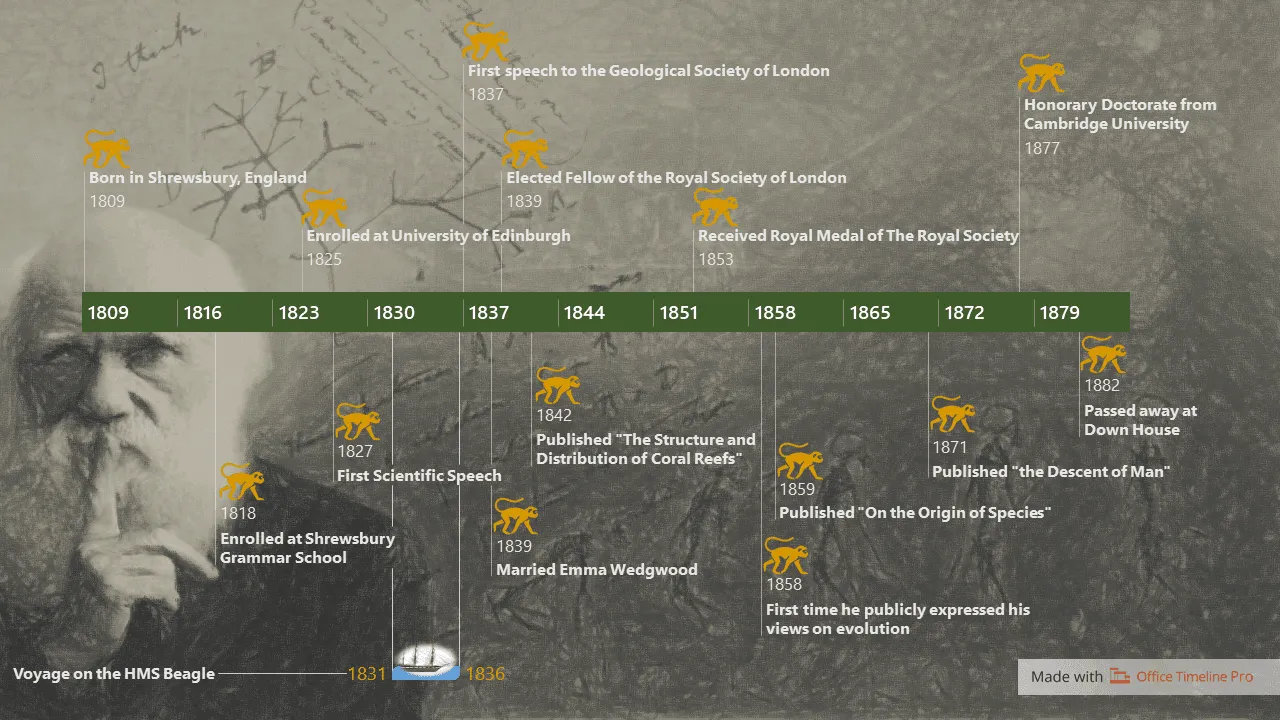Charles Darwin timeline
Explore the life and groundbreaking discoveries of Charles Darwin with our detailed timeline, highlighting key events that shaped the father of evolution's scientific journey.

On the 12th of February, the scientific community celebrates the life and achievements of Charles Darwin, one of the most influential figures in modern biology and widely regarded as the father of evolutionism. The origins of Darwin Day can be traced back to 1909, when over 400 members of the scientific community and distinguished dignitaries convened at Cambridge to honor his contributions. In the same year, both the American Museum of National History and the New York Academy of Science celebrated 100 years since the birth of Charles Darwin and 50 years since the publishing of his most important work, “On the Origin of Species”.
His proclivity for naturalism became apparent from a very early age. Young Charles Darwin grew incredibly fascinated with collecting minerals and insects alongside his brother, Erasmus, whom he joins at boarding school in 1818. However, their paths in life would diverge later on, much to the dismay of his father. Charles joined Erasmus at the University of Edinburgh Medical School but grew bored with the lectures and was unable to stomach surgery.
Darwin’s penchant for understanding the world around him was sparked by the works of brilliant minds of the era, such as John Herschel, Alexander von Humboldt and Adam Sedgwick. On the 27th of December 1831, Charles set sail on the HMS Beagle, a voyage reluctantly funded by his father that would take five years to complete. He would return from this trip as a prominent figure in the scientific circles of British society, as John Stevens Henslow would publish and popularize Darwin’s research in absentia.
Unfortunately, as his fame grew, the pressure of deadlines began mounting. Charles Darwin was never truly able to find an acceptable life-work balance for most of his adult life. He was bedridden for extensive periods, suffering from severe stomach pain, nausea, palpitations and many other symptoms, all stemming from stress. In his own words, “it is a cursed evil to any man to become as absorbed in any subject as I am in mine.”
The passion for research eclipsed virtually all aspects of his tumultuous existence. Even his marriage to Emma Wedgwood constituted a functional decision, one that Charles took after drafting a list of pros and cons; love would not make its way into either category. In all fairness, Darwin made no secret of his views on the matter, stating that “a scientific man ought to have no wishes, no affections, – a mere heart of stone.”
He took pride in his relentless search for the ultimate truth about the nature of life and its origins, and rejected convenient but ultimately groundless explanations, such as the existence of a “beneficent and omnipotent God”. The creationist view suggesting that all species had been engineered separately by an all-powerful entity clashed with Darwin’s own observations of how nature is an unforgiving machine forcing every form of life to adapt or perish.
These revolutionary views, which Darwin’s supporters shouted from the rooftops, earned him a resounding fame in the scientific community but drew the antipathy and mockery of theists. Broadly speaking, the concept of natural selection was not incompatible with theology; however, our descent from apes did cross a line and men of the cloth were quick to dismiss it. Caricatures from that era depict Charles Darwin’s bearded visage on the body of a monkey, creating a false analogy between all theories of evolution and Darwinism.
He passed away from heart failure on the 19th of April 1882, and by that time Darwin had gained the support of the scientific community. Thousands attended his funeral and William Spottiswoode, who presided over the Royal Society at the time, arranged for Charles Darwin to be buried at Westminster Abbey, alongside other intellectual influencers like Isaac Newton or John Herschel.
The Charles Darwin Timeline was built using the Office Timeline PowerPoint add-in, a robust and easy-to-use project management tool capable of creating attractive visual representations of your data within minutes. Check out the add-in's free trial and explore the powerful features that it brings.
You can download the Charles Darwin timeline as a PowerPoint file and enter any historical milestones that you believe we may have missed. Have a happy Darwin Day!
Project management tips and tricks
Turn project data into professional timelines
Get the advanced features of Office Timeline free for 14 days.


